Pedilanthus: description, types and care at home

Pedilanthus is a shrub from the Euphorbia family, the class is dicotyledonous. It is a subtropical plant native to the rainforests of North, Central and South America. In its natural habitat, the shrub branches strongly and is able to grow up to 3 meters in size. Under the conditions of the Russian climate, pedilanthus is widespread as an indoor and greenhouse plant. It is appreciated for its decorative appearance and is capable of decorating any interior.
Plants belonging to the Euphorbia family are succulents, which means that they can accumulate water reserves inside themselves.
Thanks to this feature, the branches and leaves of pedilanthus look massive, and he himself can do without moisture for a long time. In addition, this representative of the tropical flora draws attention to itself during flowering.
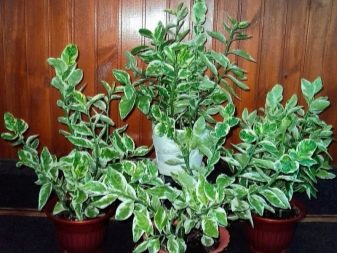
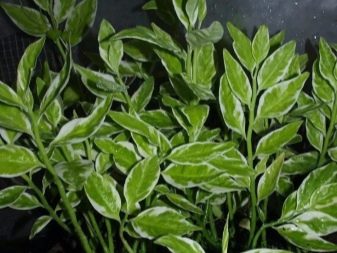

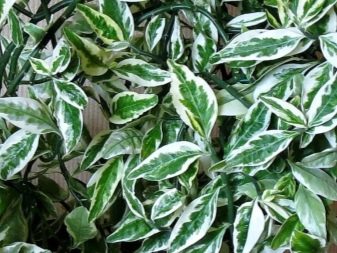
Peculiarities
The indoor flower pedilanthus has strong, cylindrical curved stems, on which ovoid leaves are arranged alternately, pointed at the end. In some varieties, the leaves can be wavy, variegated, and sometimes pubescent. The color of the leaf plate is dark green or olive. Outwardly, the leaves of the plant look like they are waxy. Not all types of pedilanthus have adapted to breeding at home, but only a small part of them. Most often in flower shops and nurseries you can find on sale variegated pedilanthus variety. But in general, each subspecies of this plant has its own leaf color - it can be bright green, greenish-light green and even gray-green.
The plant has a fast growth - by planting a small stalk, literally in 12 months, you will get a voluminous bush. The stems of this flower are capable of strong branching, so you can easily form the crown of your bush at your discretion. In the event of an acute lack of moisture, pedilanthus can completely shed all leaves and maintain vitality thanks to the fleshy stems, in which it has a supply of water and nutrients.
If you break such a stem, you will see a liquid that resembles milk in color, which is why the plant belongs to the euphorbia family.
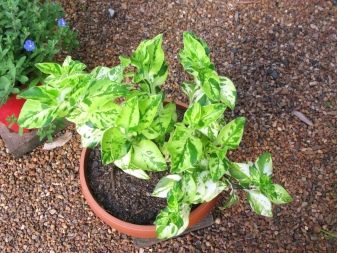
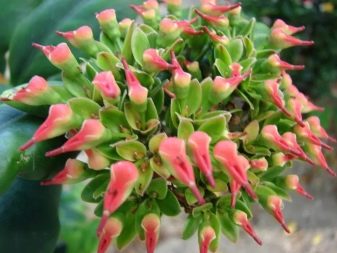
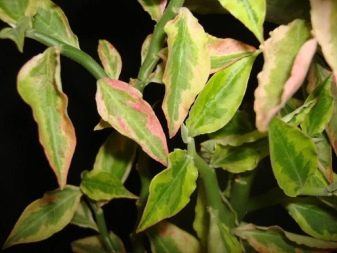
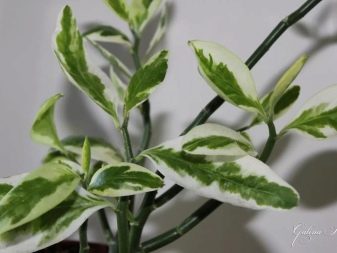
This exotic perennial is poisonous, so try to avoid getting its juice on the skin of the hands and mucous membranes of the eyes. When working with this flower be sure to use protective equipment. If the milky juice of a perennial gets on the wounds, you will immediately feel a tingling sensation. Despite the toxicity, it is known that antimicrobial drugs are made from the sap of the plant.
Pedilanthus blooms in the autumn. Its buds are small, their color is red, they are sometimes compared to small birds or shoes. The flower stalks of the plant are formed at the ends of the shoots. For flowering, it needs coolness - the optimal temperature is the range of +13.15 degrees Celsius. In addition, the flower needs to reduce watering and stop fertilizing.
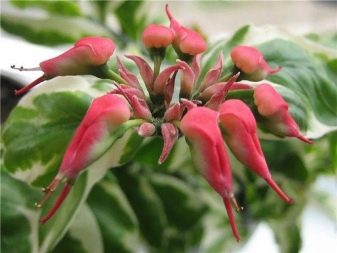


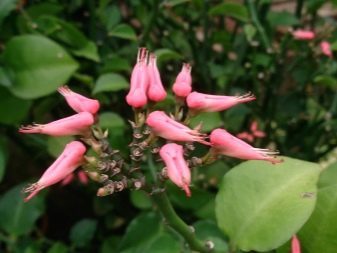
Varieties
There are many species in the genus pedilanthus. These species have a variety of shapes and colors, the main thing is that they have evolved the ability to adapt to various climatic conditions by evolution.Depending on the temperature range, light regime and humidity level, the plant changes its characteristics and external variegated appearance.
The most common are several types of pedilanthus.
- Titimaloid - the most popular type of shrub of all its fellows. It is appreciated for the high decorativeness of the color of the leaves - it is variegated. The leaf is green in color, and its edges are white, and there are white blotches along the leaf plate. It is not uncommon to find specimens of plants in which the pointed ends of oval leaves have a pinkish tint. The stem of the titimaloid pedilanthus grows in a zigzag manner. This feature is due to the fact that each new leaf, growing, changes the direction of growth of the stem.
Often, in addition to the usual name, the titimaloid species is called the "devil's backbone". The motley handsome blooms in autumn, inflorescences are formed at the ends of the shoots, the buds are red.

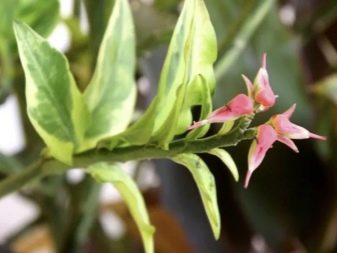
- Finca - this species loves conditions of high humidity. Its stem grows in a zigzag manner, and its leaves are small. The shrub is stunted in comparison with other types of pedilanthus - its size does not exceed one and a half meters. The color of the leaves is monochromatic, green. The decorative beauty lies in the curved stems. The deciduous mass of the plant is mostly in the upper parts of the shoots, while their lower part is bare. The buds and flowers of the plant are small, red in color.
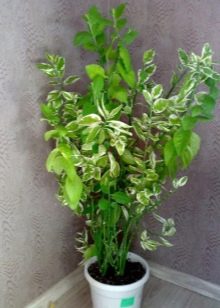
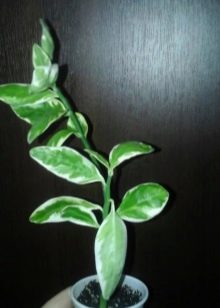

- Koalkomanensky - the species has the peculiarity of shedding leaves during the dormant period, which occurs in winter. The leaves of such a pedilanthus are compact, leathery, and small in size. The color of the leaf is monochromatic, light olive. The decorativeness of the plant lies in its large-sized inflorescences, which reach a diameter of up to 3-4 centimeters. The blossoming flowers are dark pink or bright red in color.
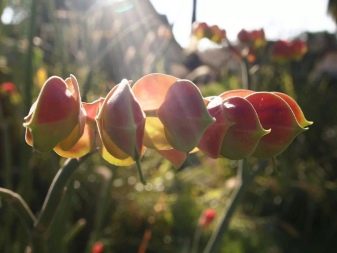
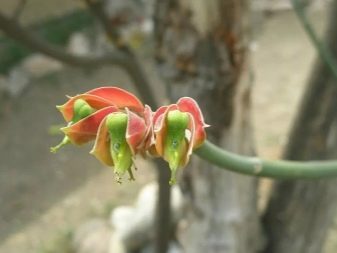
- Large-fruited - the species resembles a bush in shape, but there are practically no leaves on its trunks. All moisture and nutrients are stored in the plant in well-developed fleshy stems. Sometimes adult shoots become flat over time, their color is gray-green. Peduncles are located at the ends of the shoots - their number is small, and they are small. This type of pedilanthus is not used as a house plant.
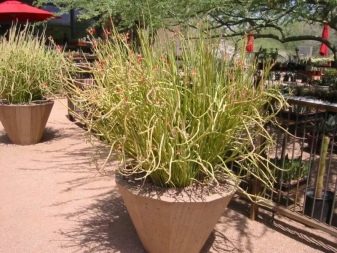
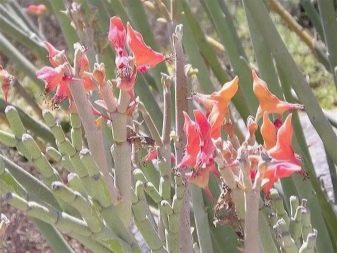
To decorate interiors, they are most often grown titimaloid type of pedilanthus. This variegated handsome man always looks impressive and attracts attention.
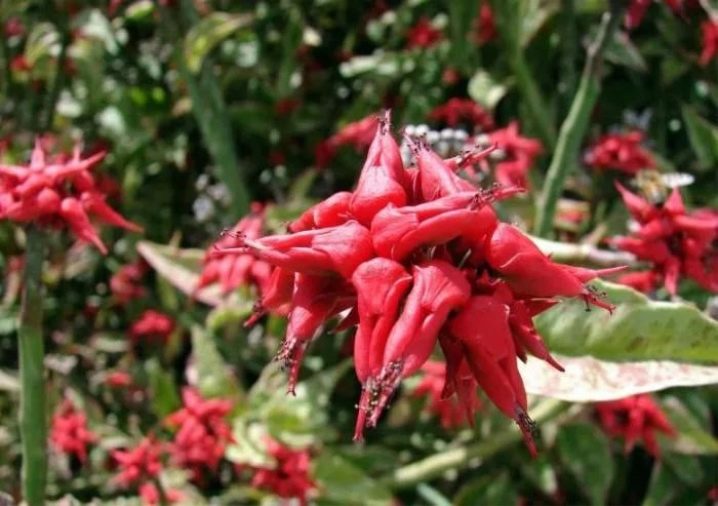
Conditions of detention
Pedilanthus can be kept at home, the flower grows quickly and changes its appearance. This perennial is tenacious and hardy, it does not require your increased attention. However, in order for an exotic handsome man to be comfortable, you need to know some subtleties.
For active growth, a perennial needs a cramped pot. If the container for growing it is large in volume, then the flower will direct all the forces to take up free space in the pot by growing the root system. In this case, the aboveground part of the plant will temporarily stop growing.
If you notice that your pet has outgrown the old pot, choose a new container for planting 2-3 centimeters larger than the previous one. Besides, during transplantation, the earthen lump cannot be destroyed, since the roots of the plant are fragile and can be easily damaged.
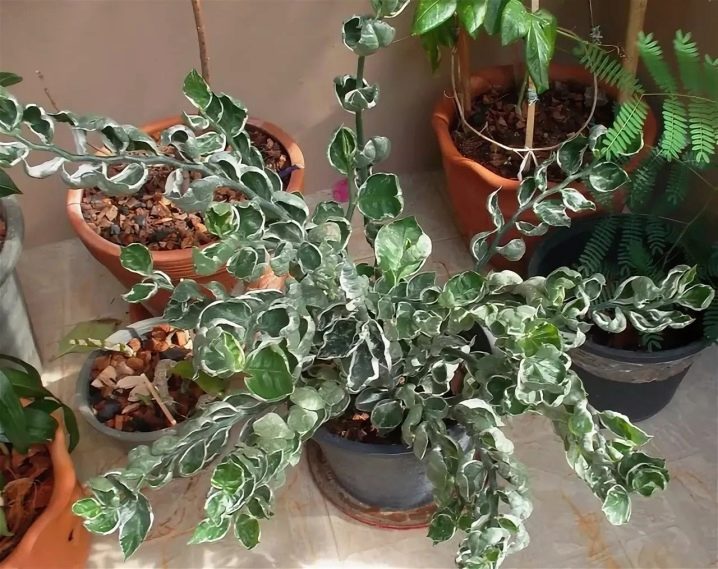
It is also not necessary to trim the roots of the pedilanthus during transplantation., do this procedure only if there are areas of decay on the roots. After removing non-viable areas, the cut sites are sprinkled with coal powder to prevent the development of rot.
The plant does not need an annual spring transplant, but without fail it needs to replace the upper part of the soil, while all the earth is carefully removed from the pot to a depth of three centimeters, and fresh soil is immediately poured in its place.
It is advisable to radically transplant a flower once every 3-4 years, not more often.
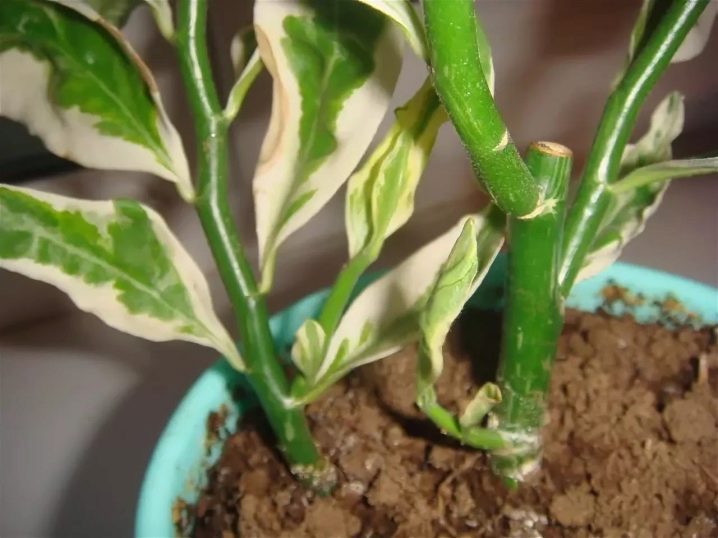
Location and lighting
Pedilanthus loves bright, but at the same time, diffused light. In darkened areas in the back of the room, the plant will lose its variegation, and if directed sunlight hits it, the leaves of the flower may suffer from burns. Experts believe that the best place for this shrub to live is the windows facing east or west. In the winter season, the plant can be transferred to the south side, since the pedilanthus needs intense lighting.
If you see that there is not enough natural light for the plant, it needs to be supplemented with a phytolamp.

Temperature and humidity
For flowering, pedilanthus needs to create a certain temperature regime. Euphorbia blooms, provided that in the winter months of the dormant period, the air temperature is no more than +15 degreesand in the summertime it will keep within +25 degrees Celsius. In the event that in the room where this deciduous shrub grows, the temperature is kept at the same level all year round, the formation of buds will not occur, and the decorative color of the flower may change to an ordinary monotonous green color.
The tropics loves humidified air.
It is especially important to spray the flower during the summer heat in order to stabilize the temperature background around it. The optimum humidity for it is considered to be 60%. The plant does not like active ventilation, and in a draft it can get sick.

How to take care of it properly?
Taking care of a plant at home means not only providing it with comfortable conditions, but also proper watering, as well as pruning the bush to form its crown. Any discomfort affects the appearance of the flower - it doesn't matter if it is an adult or a young plant.

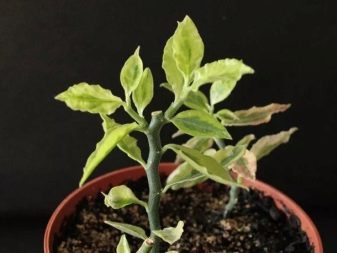
Watering
A perennial is sensitive to a lack of moisture. And although, like all succulents, during a drought, he will be able to survive offline due to the water reserves in the stems, he will completely lose his ornamental foliage. The amount of watering a flower depends on the season. In summer, the plant needs abundant watering, and in winter, with the onset of dormancy in the plant, the frequency of watering will need to be reduced. Water the flower as soon as you see that the topsoil has begun to dry out.
If the plant is small in size, then you can saturate it with moisture by immersing the pot in a container of water, where the flower absorbs moisture through the drainage holes of the pot for 15 minutes, and then the pot is removed from the water, and the excess liquid is allowed to drain.
For watering, you must use settled water at room temperature.
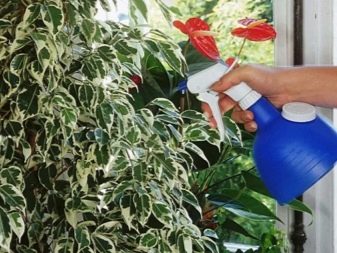
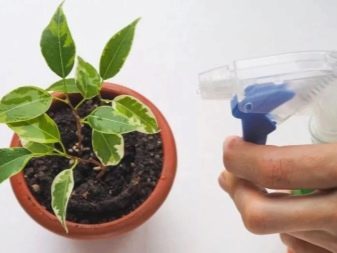
Top dressing
For feeding pedilanthus, you can use mineral fertilizers with a very low content of nitrogenous substances. The fact is that at high nitrogen concentrations in the plant, the root system rots, and the color of the foliage becomes the usual green. The succulent does not need frequent feeding, it is enough to apply fertilizer once every 20 days and only in the warm season, starting in March and ending in October. No feeding is required in winter.

Pruning
The rapid growth of the shrub requires adjustment, and in order to form the crown, the pedilanthus must be regularly cut off. If you neglect pruning, then the plant will have an unkempt appearance with shoots elongated in a chaotic direction. You can form a beautiful bush shape already at the end of winter. - that is, in the last days of February or in the first ten days of March. At this time, pruning will not cause significant damage to the succulent - due to the slow movement of the juices, the plant will not lose much moisture, and the cut sites will dry out quickly.
The cut is made over the dormant buds, which are located in the leaf internodes of the shoot. If you just pinch the top of the shoot, and there will be a long distance to the dormant buds, then this part of the stem will simply wither over time and wither away to the place of a living bud.
However, this process will be long, and it does not look quite aesthetically pleasing, so it is best to immediately prune where the flower needs it.

In some cases, milkweed requires a more radical pruning. Don't be afraid to do it... The plant will perfectly cope with this necessary measure, but only if you leave at least a couple of living dormant buds on the stems, from which new shoots will go in the future.
1-2 days before the time of pruning, watering the flower is stopped. Next, trimming is carried out using a clean, sharp knife or pruning shears. After trimming, the sections are treated with coal powder. And only after 2-3 days, when the places of the cuts are dry, the flower can be watered as usual.
Reproduction
After the formation of the pedilanthus crown, you will have a large number of cut off shoots. The plant propagates by cuttings, and this planting material can be prepared for rooting. It is easiest to propagate pedilanthus by cuttings, although there is also a way to grow it from seeds.
Cuttings for rooting need to be cut up to 15 centimeters long, it is important that at least 2, and preferably 4, are preserved on them, dormant buds are the key to the life of the future plant. Then the milky juice that has emerged from the cuttings is washed off from the cuttings and slightly dried in air. Only then can the cuttings be planted in the soil substrate.
Try not to take too large a container for germinating cuttings, and plant several cuttings in it at once, since with a single planting the plant looks like a lonely twig, and if you plant it in a group, you can quickly get a voluminous bush.
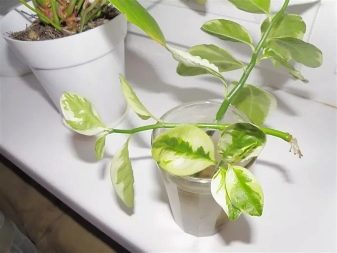
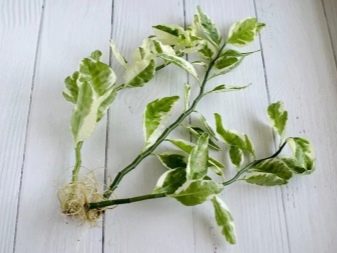
Having planted the cuttings in the soil, the container must be covered with a film or a transparent jar, creating greenhouse conditions for the seedlings, where they can quickly take root in a warm and humid environment. Every day, the container is opened and the cuttings are ventilated, removing moisture evaporation from the surface of the transparent cap. If necessary, the cuttings are watered, but this should be done in moderation, when the top layer of the earth began to dry out. The germination container is placed in a warm and bright place. Literally after 3 weeks, the cuttings take root, and the greenhouse is removed.
You can get roots on cut shoots in another way - they will appear on the seedling if you leave the shoot in water. The container with cuttings is placed in a warm, bright place, and roots are waiting for the appearance. To accelerate root growth, flower cuttings can be treated solution "Kornevin". But even without this help, in 2-3 weeks the plant will be ready for transplantation to a permanent habitat.
The plant thrives on loose substrates, but does not tolerate soil acidification.
When planting a flower in a pot, a good drainage system is created for it - for this, a layer of fine gravel is placed on the bottom of the container, and a mixture of peat, humus and river sand is poured on top of it. For looseness of the soil, add pine bark, or simply increase the proportion of sand in the total ratio of ingredients.
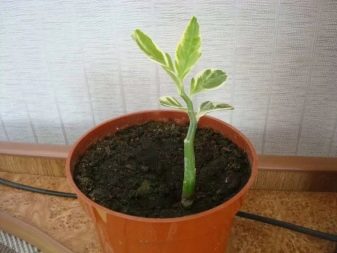
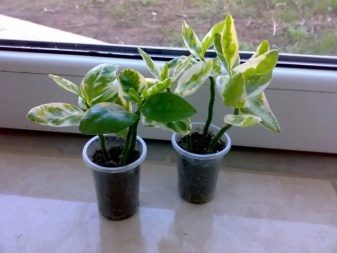
Diseases and pests
If the comfortable conditions of detention are not observed, the pedilanthus can get sick. Consider some of the symptoms that indicate that the flower is not doing well and needs help.
- The leaves of the bush are falling - this happens with improper watering, when it is not enough or, on the contrary, in excess. Another reason when a flower sheds foliage may be lack of lighting. If the pedilanthus threw off the leaves in winter, this may also be due to seasonality, not being a symptom of diseases.
- Leaves curl, tips dry - the symptom indicates that the plant is very hot. This happens when the direct rays of the sun fall on it, or the temperature regime and humidity are violated.
- The stem is pulled out - this happens for a number of reasons. It is possible that you do not regularly prune the plant, or in winter there is little lighting for the flower, and the air temperature is too high for it.
- The leaves of the plant turn pink - this happens when the flower has been under the rays of the summer sun for a long time. This condition does not harm the pedilanthus and is considered a natural occurrence.
- Bush asymmetry - happens when the plant is directed with one side towards the light source, and the other towards the room. The reason may be the opposite situation - some obstacle (for example, window glass) interferes with the growth of shoots, and on the opposite side the plant grows freely. Pruning and shaping the crown, as well as regularly adjusting the position of the flower pot, will help solve this problem.
- The plant has lost its variability - decorative coloring can gradually fade away if the flower is not created in comfortable conditions. There can be two reasons - lack of light and fertilizing with fertilizers with a large amount of nitrogen.
- The stems of the aerial part turned black - the reason is soil acidification from excessive watering, or you have created excessive moisture conditions around the flower.
- The plant does not bloom - for the pedilanthus to bloom, it needs to create coolness in winter and a temperature of at least +25 degrees in summer.
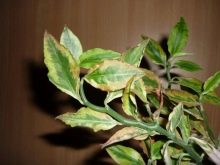
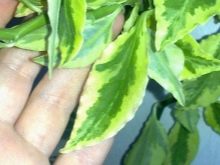
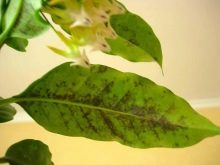
It happens that an exotic flower is attacked by insect pests. Symptoms depend on who is the culprit.
- On the reverse side of the leaf and in the area of internodes, a small cobweb is visible - this suggests that the plant was struck by a spider mite. Its clusters look like rusty spots. To combat the tick, the plant is sprayed with soapy water, and then treated with acaricidal preparations.
- The leaves of the plant roll up, dry spots are visible on them - if you look at the back of the leaf, you can see small insects of light green color. You will also find sticky white formations. Such a picture happens with an invasion of aphids that feed on the sap of the plant. You can cope with it by spraying the flower with insecticidal agents.
- Small midges swarm around the plant, the leaves of the flower turn yellow and curl - this suggests that the pedilanthus was attacked by a whitefly. Insects lay eggs on the leaves, from which larvae emerge, feeding on the sap of the plant. It is possible to eliminate this pest only with the help of repeated treatment with insecticides.
- The shape of the stems and leaves changes their shape, they have formations that look like dark cotton wool - this is how the mealybug manifests itself. It affects not only the aerial part, but also the root system of the plant. To save a flower from death, you need to process it several times with a solution of insecticidal preparations.
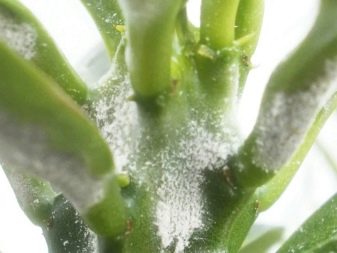
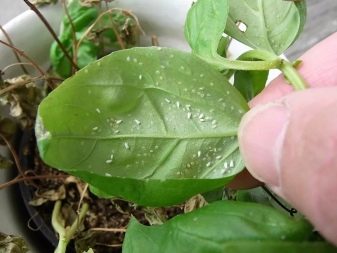
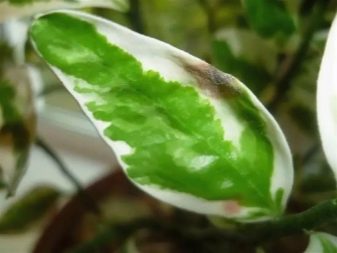

Regular care of the flower and the creation of comfortable conditions for it is a guarantee of healthy growth and development of the plant. If symptoms of a disease are detected, measures should be taken to treat the flower immediately - only in this case the plant will be able to be preserved and revived.
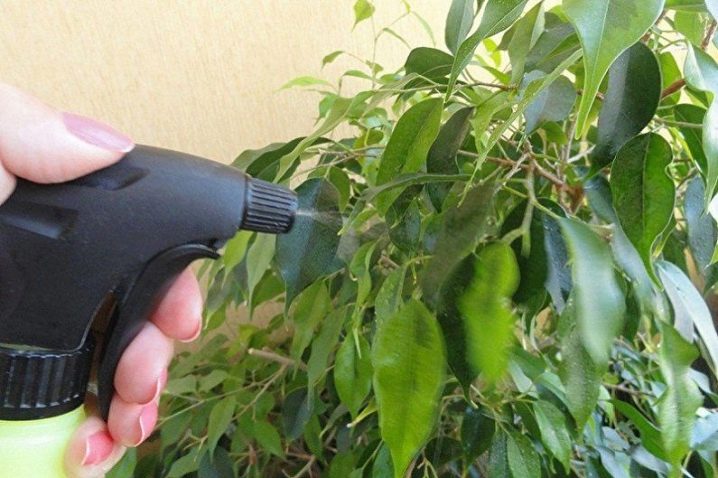
For information on how to care for a plant, see the next video.
















































Thanks a lot to the author of the article. I didn’t know the name of my bush and didn’t know how to care for it! And he really decorates my flower garden!
The comment was sent successfully.